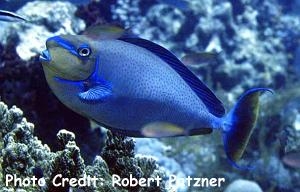
By Bob Goemans


Likely Reef Tank Suitable
Likely Fish-Only Tank Suitable
These fishes belong in the Order Perciformes and Suborder Acanthuroidei as members of the Family Acanthuridae (Surgeonfishes), which include 3 Subfamilies, 6 genera and 72 species.
Called Surgeonfish or Doctorfishes because of the scalpel-like spine at the base of the tail or Tangs because of the German word Seetang (seaweed), which relates to their eating habits. In fact, the Greek word 'acanthus' also relates to the scalpel-like spine just before the tail, i.e., caudal peduncle, hence their scientific name.
They are laterally compressed fishes, such as angelfishes and butterflyfishes, and are a favorite of most marine aquarists. Predominantly herbivorous fishes, although some also eat zooplankton and detritus. They play an important roll in controlling algae in many aquariums, although some are used as food fishes. Many have specific alga preferences. Even though mostly considered herbivorous fishes, in the aquarium they should be considered omnivorous fishes, as they all will also consume meaty foods in their diet.
Many of these species grow quite large, with some attaining a two-foot length (60 cm). Generally, a 75 gallon aquarium ought to be considered the minimum size for these fishes. Tangs not only require adequate space, they also need the right tankmates. They are active swimmers and require plenty of open space, strong water currents, and some areas to take shelter. They are constant browsers and even though they have small mouths, they have large appetites. Tangs do not fare well on once-a-day-feedings. Dried seaweed, usually referred to as Nori, is a much better foodstuff than lettuce and should be offered occasionally during the day.
Mixing different tang species of the same size and color generally create problems. Because they have little body mucus, stress can cause an outbreak of Marine Ich. Therefore they should be dissimilar in size, color, and shape. Once a pecking order is established, peace may return. Some species, i.e., a yellow tang and regal/blue tang usually tolerate each other. Ctenochaetus species are also very tolerant of other species.
My experience has shown the Chevron is the number one choice, with the Koli, Yellow, and the Sailfin tangs following in that order. The Chevron is fairly expensive, the Koli and Yellow Tang low priced, and the Sailfin, especially the Red Sea species, medium to high priced. Have even found the common Blue Tang to be quite peaceful in the reef aquarium, even though it is not mainly an alga consumer. All are quite hardy and long-lived.
Of the 72 species in six genera, the Genus Prionurus is rarely seen, probably because they live at cooler temperatures than the species in the other five genera.